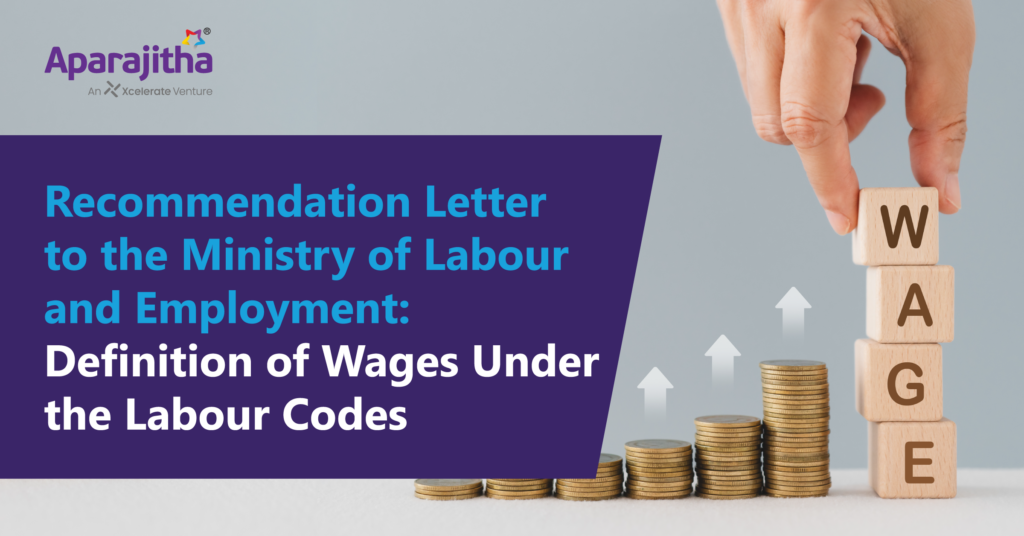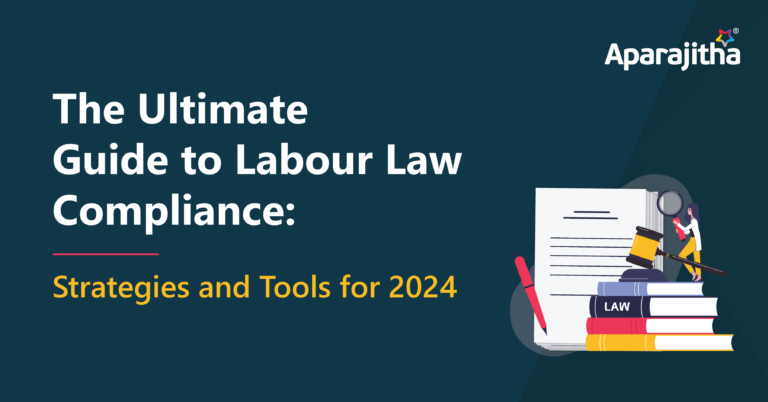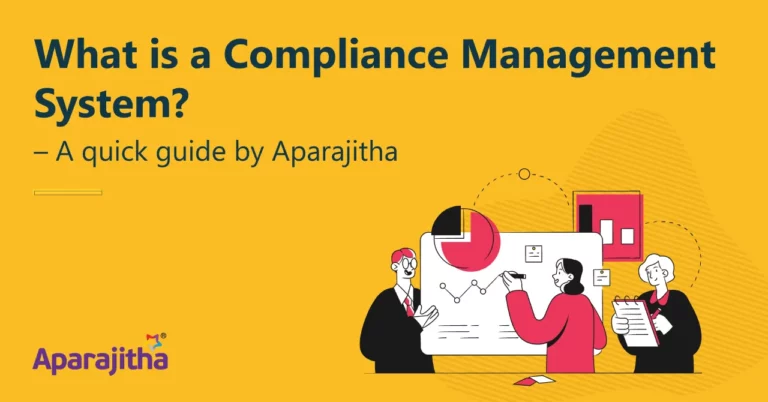- Aparajitha Corporate Services Private Limited, provides compliance services, through the use of technology to over 2000+ clients, PAN India. We offer knowledge-driven, tech-enabled Labour, Industrial and Financial Compliance Solutions across India. Our domain-specific services are crafted to assist businesses with the necessary licenses, registrations, and compliance management under various domains. Through this letter, we write to offer recommendations to address certain ambiguities in the definition of ‘Wages’ under the Labour Codes. After analyzing the Codes as they stand today, from our experience, we are offering certain recommendations, to the definition “wages” and would request clarity in terms of interpretation.
- As we are all aware that the new Code on Wages, 2019 (“Wage Code”) aims to amend and consolidate the existing four legislations, viz., The Equal Remuneration Act, The Minimum Wages Act, The Payment of Bonus Act and The Payment of Wages Act. While consolidating the four legislations mentioned hereinabove, the definitions have also become more centralized, i.e., now there is only one definition of wages under the Wage Code. While consolidating, the definitions for the term ‘wages’ under the existing four Acts have been duly considered before finalizing Section 2(y) of the Code. However, the new definition largely resembles the one in Payment of Wages Act. Section 2(y) does have several parts, viz, the substantive part, the inclusive part, the exclusion part and the provisos. Conceptually, it bears a common definition for all the four Acts, but, in its application, while, certain components like conveyance allowance, house rent allowance, etc. are excluded from being wages for Minimum Wages and Bonus purposes, these are considered as part of wages for Equal Remuneration and Payment of Wages purposes. Thus, the section reads as under:
“ ‘wages’ means all remuneration whether by way of salary, allowances or otherwise, expressed in terms of money or capable of being so expressed which would, if the terms of employment, express or implied, were fulfilled, be payable to a person employed in respect of his employment or of work done in such employment, and includes,—
(i) basic pay; (ii) dearness allowance; and (iii) retaining allowance, if any,
but does not include––
(a) any bonus payable under any law for the time being in force, which does not form part of the remuneration payable under the terms of employment;
(b) the value of any house-accommodation, or of the supply of light, water, medical attendance or other amenity or of any service excluded from the computation of wages by a general or special order of the appropriate Government;
(c) any contribution paid by the employer to any pension or provident fund, and the interest which may have accrued thereon;
(d) any conveyance allowance or the value of any travelling concession;
(e) any sum paid to the employed person to defray special expenses entailed on him by the nature of his employment;
(f) house rent allowance;
(g) remuneration payable under any award or settlement between the parties or order of a court or Tribunal;
(h) any overtime allowance
(i) any commission payable to the employee;
(j) any gratuity payable on the termination of employment;
(k) any retrenchment compensation or other retirement benefit payable to the employee or any ex gratia payment made to him on the termination of employment:
Provided that, for calculating the wages under this clause, if payments made by the employer to the employee under clauses (a) to (i) exceeds one-half, or such other per cent, as may be notified by the Central Government, of the all remuneration calculated under this clause, the amount which exceeds such one-half, or the per cent so notified, shall be deemed as remuneration and shall be accordingly added in wages under this clause:
Provided further that for the purpose of equal wages to all genders and for the purpose of payment of wages, the emoluments specified in clauses (d), (f), (g) and (h) shall be taken for computation of wage.
Explanation.––Where an employee is given in lieu of the whole or part of the wages payable to him, any remuneration in kind by his employer, the value of such remuneration in kind which does not exceed fifteen per cent. of the total wages payable to him, shall be deemed to form part of the wages of such employee;”
- In addition to the definition being common for all the wages provisions, it will also be common for all the four codes.
- Secondly, the definition for the term wages either under Minimum Wages Act or under Payment of Wages Act or Payment of Bonus Act or Equal Remuneration Act doesn’t put any cap on either the aggregate of the components which are to be included for wages or the aggregate of the components which are to be excluded. But 2(y) does. If the aggregate of the payments made to an employee under the exclusion clauses (a) to (i) exceeds one-half or such percentage as notified, the amount which exceeds such one-half or the percentage so notified would be treated as wages. Thus, for the first time, the law makers have put a cap on the payments which fall under the exclusion clause, which otherwise means, the exclusion portion cannot go beyond 50% of the total remuneration or such other percentage as notified.
- The definition in its current form could potentially mislead when people try to determine the quantum of remuneration under the section or the quantum of wages. As per the first proviso, mathematically saying, “Wages” = [All Remuneration] – [The excluded components from clauses (a) to (i)]. And, such remuneration would include ‘any contribution paid by the employer to any pension or provident fund, and the interest which may have accrued thereon’ as mentioned in clause (c). Further, after deducting the quantum of the excluded components, ‘wages’ will be determined. Let us analyse this with a simple sample salary structure as follows :
|
Components |
Amount |
|
Basic |
4000 |
|
DA |
1500 |
|
HRA [ cl (f) ] |
3000 |
|
Conveyance Allowance [ cl (d) ] |
3000 |
|
Gross 1 |
11500 |
| Employer’s contribution – PF [ 12% on Basic + DA ] [ cl ( c ) ] |
720 |
|
Gross 2 |
12220 |
- HRA, Conveyance Allowance and Employer’s Contribution towards PF are all excluded as per the proposed definition through clauses (f), (d) and (c) respectively. The sum of these components comes to Rs 6720. Naturally, this would be added along with Basic and DA to arrive at the 100% wages, which will be Rs 12220 in the above example. 50% will work out to Rs 6110. Sum of Basic and DA alone is Rs 5500 which is less than 50%. Another Rs 610 is to be added and the deemed wages would be Rs 6110 as per the proposed definition in the code on wages. Also, a portion of employer’s contribution is included in the deemed wages of Rs 6110. If an employer has to consider this quantum, it would be like paying PF contributions on PF contribution. We could end up with cases like this if we strictly apply the proposed definition.
- Whereas, in my considered opinion, the 100% wages in the above example should only be Rs 11500, ie., the Gross 1. Otherwise stated, Employer’s contributions towards PF shall not be considered even in determining the 100% wages. If this is agreed upon, the proposed definition shall be slightly modified to ensure the employers are not confused or misled while doing the calculation.
- Further, the Explanation to the Second Proviso states that ‘where an employee is given in lieu of the whole or part of the wages payable to him, any remuneration in kind by his employer, the value of such remuneration in kind which does not exceed 15% of the total wages payable to him, shall be deemed to form part of the wages of such employee.’ The intention behind this clause is to ensure that when an employer pays an employee more in kind than in cash, the value this remuneration must be included under the definition of wages. In the alternative, we also believe that the purpose of this Proviso is to ensure that the Employer does not pay beyond a certain limit (in this case, 15%) to the Employee in kind.
- However, the provision incorrectly uses the phrase ‘does not exceed’ instead of ‘shall not exceed’. If interpreted as ‘does not exceed’, it would allow an employer to pay 100% of the wages in kind without it being included in the definition of wages. Additionally, as explanation currently stands, any canteen subsidy, uniform, subsidized transport, Diwali gifts, etc., provided to an employee must be quantified and included in the definition of wages. The quantification of such benefits, including Diwali gifts and canteen subsidies, on a monthly basis for every employee, to determine whether they exceed 15%, will pose a significant challenge for employers and contradict the principles of ‘ease of doing business’
- Keeping this in mind the following modification in the definition of wages under code on wages ( as also other codes, as the definition is common ) is suggested :
|
CURRENT DEFINITION “ ‘wages’ means all remuneration whether by way of salary, allowances or otherwise, expressed in terms of money or capable of being so expressed which would, if the terms of employment, express or implied, were fulfilled, be payable to a person employed in respect of his employment or of work done in such employment, and includes,—
(i) basic pay; (ii) dearness allowance; and (iii) retaining allowance, if any,
but does not include––
(a) any bonus payable under any law for the time being in force, which does not form part of the remuneration payable under the terms of employment; (b) the value of any house-accommodation, or of the supply of light, water, medical attendance or other amenity or of any service excluded from the computation of wages by a general or special order of the appropriate Government; (c) any contribution paid by the employer to any pension or provident fund, and the interest which may have accrued thereon; (d) any conveyance allowance or the value of any travelling concession; (e) any sum paid to the employed person to defray special expenses entailed on him by the nature of his employment; (f) house rent allowance; (g) remuneration payable under any award or settlement between the parties or order of a court or Tribunal; (h) any overtime allowance (i) any commission payable to the employee; (j) any gratuity payable on the termination of employment; (k) any retrenchment compensation or other retirement benefit payable to the employee or any ex gratia payment made to him on the termination of employment:
Provided that, for calculating the wages under this clause, if payments made by the employer to the employee under clauses (a) to (i) exceeds one-half, or such other per cent, as may be notified by the Central Government, of the all remuneration calculated under this clause, the amount which exceeds such one-half, or the per cent so notified, shall be deemed as remuneration and shall be accordingly added in wages under this clause:
Provided further that for the purpose of equal wages to all genders and for the purpose of payment of wages, the emoluments specified in clauses (d), (f), (g) and (h) shall be taken for computation of wage.
Explanation.––Where an employee is given in lieu of the whole or part of the wages payable to him, any remuneration in kind by his employer, the value of such remuneration in kind which does not exceed fifteen per cent. of the total wages payable to him, shall be deemed to form part of the wages of such employee;”
|
PROPOSED CHANGES “ ‘wages’ means all remuneration whether by way of salary, allowances or otherwise, expressed in terms of money or capable of being so expressed which would, if the terms of employment, express or implied, were fulfilled, be payable to a person employed in respect of his employment or of work done in such employment, and includes,— (i) basic pay; (ii) dearness allowance; and (iii) retaining allowance, if any, but does not include–– (a) any bonus payable under any law for the time being in force, which does not form part of the remuneration payable under the terms of employment; (b) the value of any house-accommodation, or of the supply of light, water, medical attendance or other amenity or of any service excluded from the computation of wages by a general or special order of the appropriate Government; (c) any contribution paid by the employer to any pension or provident fund, and the interest which may have accrued thereon; (d) any conveyance allowance or the value of any travelling concession; (e) any sum paid to the employed person to defray special expenses entailed on him by the nature of his employment; (f) house rent allowance; (g) remuneration payable under any award or settlement between the parties or order of a court or Tribunal; (h) any overtime allowance (i) any commission payable to the employee; (j) any gratuity payable on the termination of employment; (k) any retrenchment compensation or other retirement benefit payable to the employee or any ex gratia payment made to him on the termination of employment: Provided that, for calculating the wages under this clause, if payments made by the employer to the employee under clauses (b), (d), (e ), (f), (g), (h) and (i) exceeds one-half, or such other per cent, as may be notified by the Central Government, of the all remuneration calculated under this clause, the amount which exceeds such one-half, or the per cent so notified, shall be deemed as remuneration and shall be accordingly added in wages under this clause: Provided further that for the purpose of equal wages to all genders and for the purpose of payment of wages, the emoluments specified in clauses (d), (f), (g) and (h) shall be taken for computation of wage.
Explanation.––Where an employee is given in lieu of the whole or part of the wages payable to him, any remuneration in kind by his employer, the value of such remuneration shall not exceed fifteen per cent. of the total wages payable to him to be deemed to form part of the wages of such employee;” |
- In light of the above, we are recommending that your good office looks at the definition of wages before it is implemented, such that the states can also adopt the modified definition. This is with the view that in case there are discrepancies after implementation, this would only lead to additional burden on the judiciary when the cases for interpretation arrive. In the alternative, a clarification may be issued to clear out any ambiguity.
VARADAN,
CHIEF CONSULTATION OFFICER,
APARAJITHA CORPORATE SERVICES (P) LTD.







